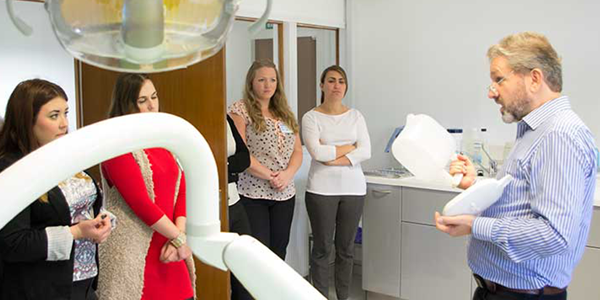Hand care in practice
dentisan technical director, Peter Bacon, describes the importance of hand hygiene in dental practices
Winter is here again and with it comes a seasonal peak in cases of colds, flu and other unpleasant illnesses such as Norovirus. Coughs and sneezes easily spread diseases and in winter, especially, dental practices can provide an ideal environment for infections to be unwittingly transferred between staff and patients.
According to the European Centre for Disease Prevention and Control, healthcare-acquired infections affect over 4 million patients a year across Europe and cost around €7 billion in additional healthcare and direct financial losses. In an attempt to slow the spread of these diseases, scientists and governments point to hand hygiene as one of the easiest and most cost-effective ways of preventing the spread of such infections, thereby avoiding the subsequent costs to clinical practice.
Every dental practice has a duty of care to ensure it is managed in accordance with current regulations and guidelines regarding hand hygiene. And with a large number of associated hand hygiene products now on the market, it is paramount to understand why hand hygiene is so important and then make an informed choice of product in order to achieve best practice.
Even routine dental procedures provide an ideal opportunity for microorganisms to be transferred between clinical staff and patients, and DCPs who come into contact with contaminated dental instruments, blood, tissue or bodily fluids are naturally at risk of infection. One major route of infection within a practice is hand to surface/hand to patient contact, whereby patients attending with a cold, for example, can easily spread the virus by hands coming into contact with surfaces such as the reception desk or door handles, posing a potential infection risk to the next person who touches them.
Section 6 of HTM 01-05 states that the term ‘hand hygiene’ covers not only hand washing, but also additional measures such as hand disinfection using antibacterial-based hand rubs and gels. It is also a requirement that hand hygiene should be part of the induction for all new staff members and this training should be refreshed to all relevant staff in the practice periodically throughout the year.
According to HTM 01-05 guidelines hand washing must take place on the following occasions:
• before and after each treatment session
• before and after the removal of PPE
• following the washing of dental instruments
• before contact with instruments that have been steam-sterilised (whether or not these instruments are wrapped)
• after cleaning or maintaining decontamination devices used on dental instruments
• at the completion of decontamination work
Hands should also be thoroughly washed when they are visibly soiled, before putting on surgical gloves and after glove removal.
It is recommended that individuals use a mild liquid soap for hand washing, preferably one manufactured for healthcare environments, as these products are normally free from perfume, have fewer allergenic components, are antibacterial and are designed for repeated use throughout the working day. These products should also contain emollients and skin conditioners to soften hands and help prevent the skin from drying and cracking. Bars of soap should not be used as they pose a risk of becoming easily colonised with Gram-negative bacteria and Pseudomonas and can therefore act as a source of contamination. Refillable hand wash dispensers should also be avoided as bacteria can easily multiply within them during the refilling process.
HTM 01-05 recommends the use of wall-mounted liquid dispensers using disposable cartridges for dispensing hand wash, creams and gels. These are designed to allow the liquid to be dispensed in a measured and cost-effective way, without human contact, greatly reducing any chance of contamination and helping to avoid wastage.
It is commonly thought that hand hygiene is best carried out using an alcohol-based hand rub. However, these rubs do not physically remove debris from hands, so whilst alcohol is an effective disinfectant for clean hands, hands that are visibly dirty or contaminated must still be washed with liquid soap first. In addition, regular use alcohol-based products can severely compromise the condition of the skin leading to dryness and irritation, making hands prone to hypersensitivity or allergic reaction. As an alternative, the use of a water-based moisturising cream or lotion can help to minimise the risk of skin damage, but communal jars of hand cream are not desirable as the contents may become contaminated and subsequently become an infection risk.
Hands should be washed under warm, running water, applying liquid soap to wet hands and ensuring all areas of the hands, including the palms, backs of the hands, knuckles, between the fingers and wrists are all thoroughly clean. Rings and other items of jewellery should be removed before washing as bacteria can colonise on the skin under these items. Rings also make the wearing of surgical gloves more difficult and make glove tears more likely. Finger nails should be kept short, clean, and free from nail varnish with no artificial nails, as these also present a known infection risk.
After washing, hands must be thoroughly dried using disposable paper towels as transmission of microorganisms is more likely when hands are damp, and inadequately dried hands are more prone to skin damage.
Hand hygiene is one of the simplest but most important measures for reducing the risk of infection transmission during patient care. Effective hand hygiene protects both patients and members of the dental team and is an essential part of a practice’s infection control policy. All staff should be provided with and encouraged to use compliant and high-quality hygiene products that reach recognised and approved British and European industry standards. In this way, the practice can provide both staff and patients with the best possible protection from potential infection risk.







